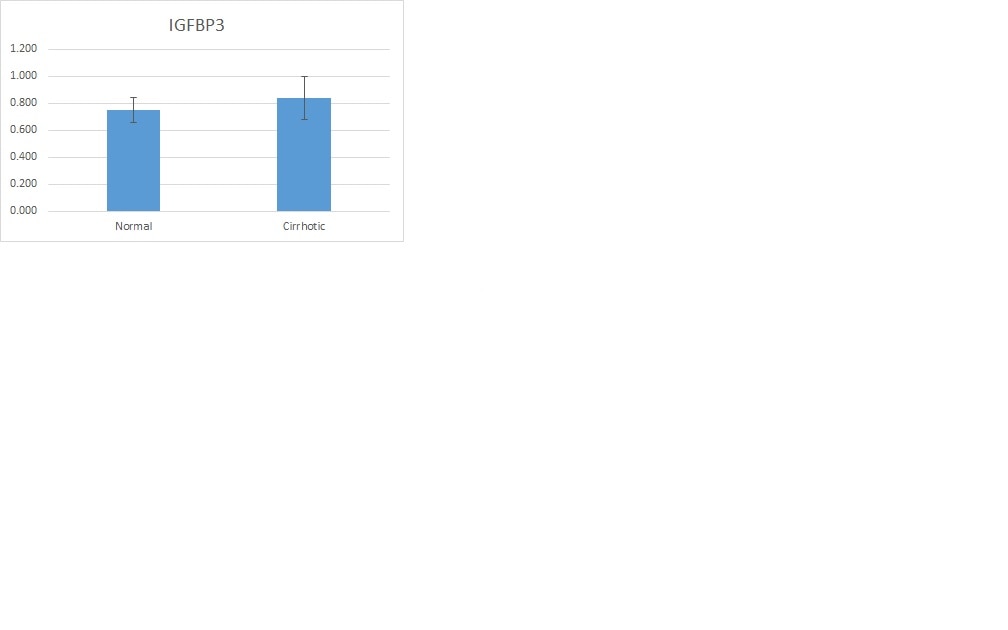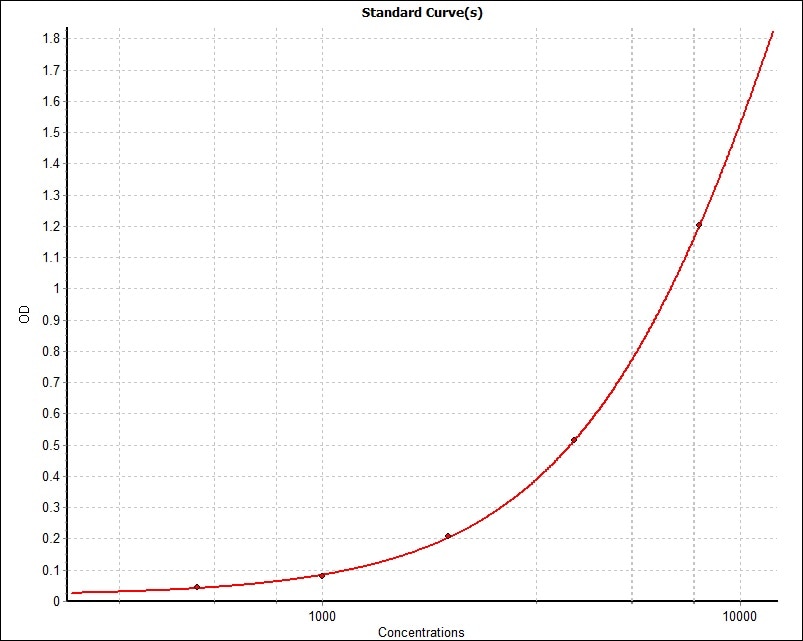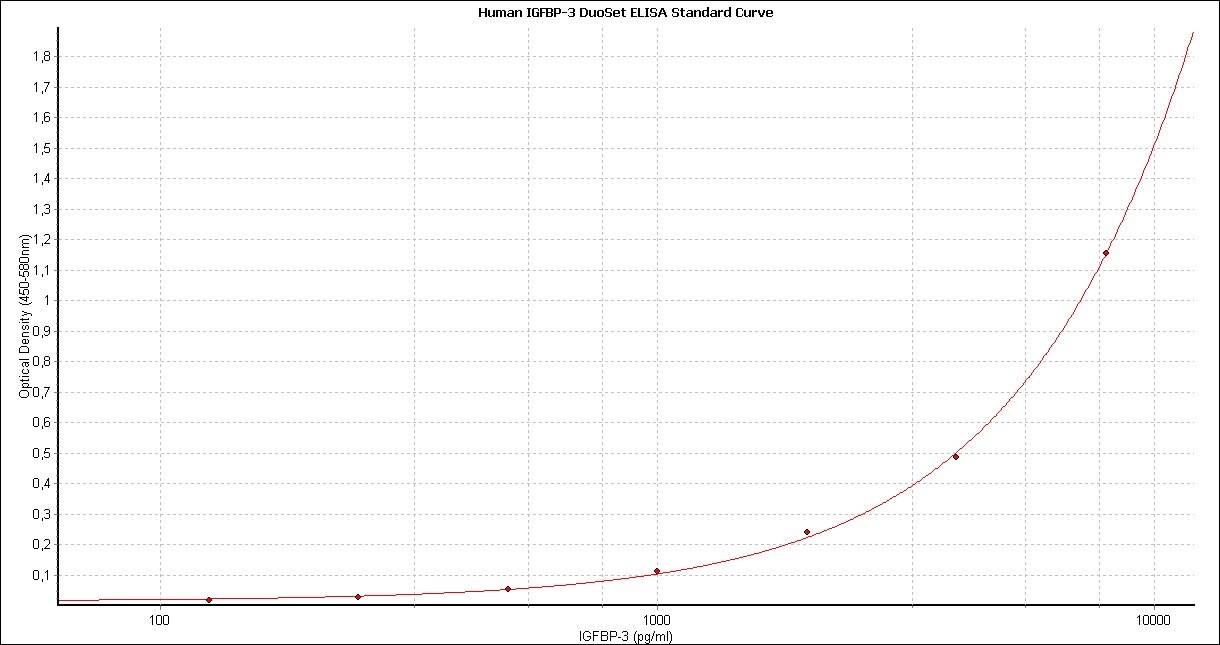Human IGFBP-3 DuoSet ELISA Summary
* Provided that the recommended microplates, buffers, diluents, substrates and solutions are used, and the assay is run as summarized in the Assay Procedure provided.
This DuoSet ELISA Development kit contains the basic components required for the development of sandwich ELISAs to measure natural and recombinant human IGFBP-3. The suggested diluent is suitable for the analysis of most cell culture supernate samples. Diluents for complex matrices, such as serum and plasma, should be evaluated prior to use in this DuoSet.
Product Features
- Optimized capture and detection antibody pairings with recommended concentrations save lengthy development time
- Development protocols are provided to guide further assay optimization
- Assay can be customized to your specific needs
- Economical alternative to complete kits
Kit Content
- Capture Antibody
- Detection Antibody
- Recombinant Standard
- Streptavidin conjugated to horseradish-peroxidase (Streptavidin-HRP)
Other Reagents Required
DuoSet Ancillary Reagent Kit 3 (5 plates): (Catalog # DY009) containing 96 well microplates, plate sealers, substrate solution, stop solution, plate coating buffer (PBS), wash buffer, and Reagent Diluent Concentrate 3.
Normal Goat Serum: (Catalog # DY005)
The components listed above may be purchased separately:
PBS: (Catalog # DY006), or 137 mM NaCl, 2.7 mM KCl, 8.1 mM Na2HPO4, 1.5 mM KH2PO4, pH 7.2 - 7.4, 0.2 µm filtered
Wash Buffer: (Catalog # WA126), or 0.05% Tween® 20 in PBS, pH 7.2-7.4
Reagent Diluent: 5% Tween 20 plus 2% Normal Goat Serum in PBS
pH 7.2-7.4, 0.2 μm filtered (R&D Systems®, Catalog # DY004 and
DY005).
Substrate Solution: 1:1 mixture of Color Reagent A (H2O2) and Color Reagent B (Tetramethylbenzidine) (Catalog # DY999)
Stop Solution: 2 N H2SO4 (Catalog # DY994)
Microplates: R&D Systems (Catalog # DY990)
Plate Sealers: ELISA Plate Sealers (Catalog # DY992)
Scientific Data
Product Datasheets
Preparation and Storage
Background: IGFBP-3
The superfamily of insulin-like growth factor (IGF) binding proteins include the six high-affinity IGF binding proteins (IGFBP) and at least four additional low-affinity binding proteins referred to as IGFBP related proteins (IGFBP-rP). All IGFBP superfamily members are cysteine-rich proteins with conserved cysteine residues, which are clustered in the amino- and carboxy-terminal thirds of the molecule. IGFBPs modulate the biological activities of IGF proteins. Some IGFBPs may also have intrinsic bioactivity that is independent of their ability to bind IGF proteins. Post-translational modifications of IGFBP, including glycosylation, phosphorylation and proteolysis, have been shown to modify the affinities of the binding proteins to IGF. ALS (Acid Labile Subunit) is a liver-derived protein that exists in a ternary complex with Insulin-like Growth Factor (IGF)-binding Protein-3 (IGFBP-3) or IGFBP-5, and either IGF-I or IGF-II. ALS increases the half-life of IGF/IGFBP complexes in circulation.
Assay Procedure
GENERAL ELISA PROTOCOL
Plate Preparation
- Dilute the Capture Antibody to the working concentration in PBS without carrier protein. Immediately coat a 96-well microplate with 100 μL per well of the diluted Capture Antibody. Seal the plate and incubate overnight at room temperature.
- Aspirate each well and wash with Wash Buffer, repeating the process two times for a total of three washes. Wash by filling each well with Wash Buffer (400 μL) using a squirt bottle, manifold dispenser, or autowasher. Complete removal of liquid at each step is essential for good performance. After the last wash, remove any remaining Wash Buffer by aspirating or by inverting the plate and blotting it against clean paper towels.
- Block plates by adding 300 μL of Reagent Diluent to each well. Incubate at room temperature for a minimum of 1 hour.
- Repeat the aspiration/wash as in step 2. The plates are now ready for sample addition.
Assay Procedure
- Add 100 μL of sample or standards in Reagent Diluent, or an appropriate diluent, per well. Cover with an adhesive strip and incubate 2 hours at room temperature.
- Repeat the aspiration/wash as in step 2 of Plate Preparation.
- Add 100 μL of the Detection Antibody, diluted in Reagent Diluent, to each well. Cover with a new adhesive strip and incubate 2 hours at room temperature.
- Repeat the aspiration/wash as in step 2 of Plate Preparation.
- Add 100 μL of the working dilution of Streptavidin-HRP to each well. Cover the plate and incubate for 20 minutes at room temperature. Avoid placing the plate in direct light.
- Repeat the aspiration/wash as in step 2.
- Add 100 μL of Substrate Solution to each well. Incubate for 20 minutes at room temperature. Avoid placing the plate in direct light.
- Add 50 μL of Stop Solution to each well. Gently tap the plate to ensure thorough mixing.
- Determine the optical density of each well immediately, using a microplate reader set to 450 nm. If wavelength correction is available, set to 540 nm or 570 nm. If wavelength correction is not available, subtract readings at 540 nm or 570 nm from the readings at 450 nm. This subtraction will correct for optical imperfections in the plate. Readings made directly at 450 nm without correction may be higher and less accurate.
Citations for Human IGFBP-3 DuoSet ELISA
R&D Systems personnel manually curate a database that contains references using R&D Systems products. The data collected includes not only links to publications in PubMed, but also provides information about sample types, species, and experimental conditions.
13
Citations: Showing 1 - 10
Filter your results:
Filter by:
-
Prediction of emergency cerclage outcomes in women with cervical insufficiency: The role of inflammatory, angiogenic, and extracellular matrix-related proteins in amniotic fluid
Authors: KN Lee, KH Park, YM Kim, I Cho, TE Kim
PLoS ONE, 2022-05-10;17(5):e0268291.
Species: Human
Sample Types: Amniotic Fluid
-
Dipeptidyl peptidase-4 inhibitors reduced long-term cardiovascular risk in diabetic patients after percutaneous coronary intervention via insulin-like growth factor-1 axis
Authors: Y Chikata, H Iwata, K Miyosawa, T Koike, H Yasuda, T Funamizu, S Doi, H Endo, H Wada, R Naito, M Ogita, T Dohi, T Kasai, K Isoda, S Okazaki, K Miyauchi, T Minamino
Scientific Reports, 2022-03-24;12(1):5129.
Species: Human
Sample Types: Serum
-
A standardized gnotobiotic mouse model harboring a minimal 15-member mouse gut microbiota recapitulates SOPF/SPF phenotypes
Authors: M Darnaud, F De Vadder, P Bogeat, L Boucinha, AL Bulteau, A Bunescu, C Couturier, A Delgado, H Dugua, C Elie, A Mathieu, T Novotná, DA Ouattara, S Planel, A Saliou, D Šr?tková, J Yansouni, B Stecher, M Schwarzer, F Leulier, A Tamellini
Nature Communications, 2021-11-18;12(1):6686.
Species: Mouse
Sample Types: Serum
-
Effect of anthelmintic treatment on serum free IGF-1 and IGFBP-3: a cluster-randomized-controlled trial in Indonesia
Authors: F Kurniawan, DL Tahapary, K de Ruiter, E Yunir, NR Biermasz, JWA Smit, T Supali, E Sartono, M Yazdanbakh, P Soewondo
Sci Rep, 2020-11-04;10(1):19023.
Species: Human
Sample Types: Serum
-
Using a cultural dance program to increase sustainable physical activity for breast cancer survivors-A pilot study
Authors: LWM Loo, K Nishibun, L Welsh, T Makolo, CD Chong, I Pagano, H Yu, EO Bantum
Complement Ther Med, 2019-09-21;47(0):102197.
Species: Human
Sample Types: Plasma
-
MODELING STROMA-INDUCED DRUG RESISTANCE IN A TISSUE-ENGINEERED TUMOR MODEL OF EWING SARCOMA
Authors: Marco Santoro
Tissue Eng Part A, 2017-01-01;0(0):.
Species: Human
Sample Types: Cell Culture Supernates
-
Antitumor activity and immunogenicity of recombinant vaccinia virus expressing HPV 16 E7 protein SigE7LAMP is enhanced by high-level coexpression of IGFBP-3.
Authors: Musil, J, Kutinova, L, Zurkova, K, Hainz, P, Babiarova, K, Krystofova, J, Nemeckova, S
Cancer Gene Ther, 2014-02-21;21(3):115-25.
Species: Mouse, Primate - Chlorocebus aethiops (African Green Monkey)
Sample Types: Cell Lysates
-
Human IGF Binding Protein-3 Overexpression Impairs Glucose Regulation in Mice via an Inhibition of Insulin Secretion.
Authors: Nguyen KH, Yao XH, Moulik S, Mishra S, Nyomba BL
Endocrinology, 2011-03-29;152(6):2184-96.
Species: Human
Sample Types: Plasma
-
Biological effects induced by insulin-like growth factor binding protein 3 (IGFBP-3) in malignant melanoma.
Authors: Oy GF, Slipicevic A, Davidson B, Solberg Faye R, Maelandsmo GM, Florenes VA
Int. J. Cancer, 2010-01-15;126(2):350-61.
Species: Human
Sample Types: Cell Culture Supernates
-
IGF-I and IGFBP-3 augment transforming growth factor-beta actions in human renal carcinoma cells.
Authors: Rosendahl AH, Forsberg G
Kidney Int., 2006-09-13;70(9):1584-90.
Species: Human
Sample Types: Cell Culture Supernates
-
Mining the acute respiratory distress syndrome proteome: identification of the insulin-like growth factor (IGF)/IGF-binding protein-3 pathway in acute lung injury.
Authors: Schnapp LM, Donohoe S, Chen J, Sunde DA, Kelly PM, Ruzinski J, Martin T, Goodlett DR
Am. J. Pathol., 2006-07-01;169(1):86-95.
Species: Human
Sample Types: BALF
-
Thrombospondin 1, produced by endothelial cells under the action of erythropoietin, stimulates thymidine incorporation into erythroid cells and counteracts the inhibitory action of insulin-like growth factor binding protein 3.
Authors: Congote LF, DiFalco MR, Gibbs BF
Cytokine, 2005-03-23;30(5):248-53.
Species: Human
Sample Types: Whole Cells
-
Epidermal growth factor receptor regulates aberrant expression of insulin-like growth factor-binding protein 3.
Authors: Takaoka M, Harada H, Andl CD, Oyama K, Naomoto Y, Dempsey KL, Klein-Szanto AJ, El-Deiry WS, Grimberg A, Nakagawa H
Cancer Res., 2004-11-01;64(21):7711-23.
Species: Human
Sample Types: Cell Culture Supernates
FAQs
No product specific FAQs exist for this product, however you may
View all ELISA FAQsReviews for Human IGFBP-3 DuoSet ELISA
Average Rating: 4.3 (Based on 3 Reviews)
Have you used Human IGFBP-3 DuoSet ELISA?
Submit a review and receive an Amazon gift card.
$25/€18/£15/$25CAN/¥75 Yuan/¥2500 Yen for a review with an image
$10/€7/£6/$10 CAD/¥70 Yuan/¥1110 Yen for a review without an image
Filter by:





